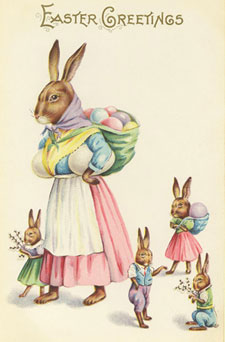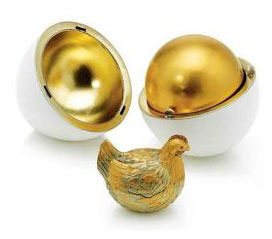
-
Easter Facts
- Easter is a “moveable feast” celebrated on the first Sunday after the full moon which happens on or after March 21, the Spring Equinox.
- The first symbol of Easter was a chicken breaking out of its shell (Christ's resurrection).
- The tradition of giving eggs at Easter time has been traced back to Persians, Egyptians, Gauls, Greeks and Romans, to whom the egg was a symbol of life.
- The name Easter originates from Eastre, the Anglo-Saxon goddess who symbolizes hare and egg.
- The traditional act of painting eggs is called Pysanka (origins from the Ukranian word pysaty, “to write”)
- 76 percent of people eat the ears on chocolate bunnies first.
- The first chocolate eggs were made in Europe in the early 1800s and still are one of the most popular treats associated with Easter.
- Every year, the White House hosts an Easter Egg Roll on the front lawn. The tradition was started by President Rutherford B. Hayes in 1878. In 1878 President Hayes and his wife Lucy officially opened the White House grounds to the children of the area for egg rolling on Easter Monday. The event has been held on the South Lawn ever since, except during World War I and World War II. During the war years the Easter Egg Roll was held at the National Zoo, and other Washington locations.
- The world’s largest jar of jelly beans weighed 6,050 pounds.
- Many pagan traditions have found their way into Christian religious observances. Rabbits are one such symbol. Rabbits symbolize the fertility of springtime. The rabbit is also the symbol of the Egyptian moon — and the moon is used to determine the date of Easter each year.
- The hare (rabbit) is a very important Easter symbol in Germany, almost as important as Santa Claus is in the United States for Christmas. The hare is responsible for laying eggs and hiding them. This probably evolved from children hunting for Easter eggs and scaring away rabbits which happened to be in the area. The hare and egg provide a link between the pagan faith's welcoming of spring and Christianity's Easter celebration.
-
The life hidden within the shell of the egg is mysterious and unknown. Who knows whether the creature that emerges will be good or bad? Therefore, great hopes and prayers are associated with the unborn life that is yet unseen but lies asleep within the egg. - Among ancient Egyptians, the original (or "world") egg is the joint production of the god "Geb", whose body is the earth, and the goddess "Nut", the sky. From this first egg was born the "Bennyu" - the bird of Phoenix, the sun symbol. Another ancient Egyptian religious system called the chief god "Ptah". Drawings found by archaeologists show Ptah seated on a throne, before a potter's wheel, fashioning a golden egg - the beginning of life.
- In Hindu mythology, the first, or "world", egg, was described as formed in the waters of chaos before the beginning of both universe and time. Another branch of ancient Hindu belief pictured the original egg as being laid by their divinity, Hamsa.
- Phoenicians believed that the first egg was formed in Mot, the original, or primeval, waters.
- In the Finnish epic, "The Kalevala", their greatest god, "Ukko", formed the earth, sky, sun, moon and clouds from the broken eggs of a teal.
- In keeping with almost all ancient beliefs, the Persians accepted that the world was hatched from an egg on the first day of spring. Their New Year's festival was celebrated at a time corresponding to Easter. Upon this joyous occasion they had a unique custom - they exchanged dyed eggs as good luck charms. The practice spread throughout the world. Today, children look for colored eggs in the Easter basket.
- The egg had always intrigued, worried and fascinated people. For instance, in antiquity, the Romans used to break the shells of eggs that they had eaten to prevent enemies from making magic with them. It was believed that evil Romans could cast curses by remote control with discarded empty uncrushed egg shells.
- It had been suggested that the many customs associated with Easter eggs developed in Europe because of the Crusaders. They are believed to have brought the idea back with them from the East.
- Thus, we see that the egg has had special meaning and has been revered by humankind for thousands of years as a symbol of birth, life and hope.
-
 The most famous decorated Easter eggs were those made by the well-known goldsmith, Peter Carl Faberge. In 1883 the Russian Czar, Alexander, commissioned Faberge to make a special Easter gift for his wife, the Empress Marie.The first Faberge egg was an egg within an egg. It had an outside shell of platinum and enameled white which opened to reveal a smaller gold egg. The smaller egg, in turn, opened to display a golden chicken and a jeweled replica of the Imperial crown. This special Faberge egg so delighted the Czarina that the Czar promptly ordered the Faberge firm to design further eggs to be delivered every Easter. In later years Nicholas II, Alexander's son, continued the custom. Fifty-seven eggs were made in all.
The most famous decorated Easter eggs were those made by the well-known goldsmith, Peter Carl Faberge. In 1883 the Russian Czar, Alexander, commissioned Faberge to make a special Easter gift for his wife, the Empress Marie.The first Faberge egg was an egg within an egg. It had an outside shell of platinum and enameled white which opened to reveal a smaller gold egg. The smaller egg, in turn, opened to display a golden chicken and a jeweled replica of the Imperial crown. This special Faberge egg so delighted the Czarina that the Czar promptly ordered the Faberge firm to design further eggs to be delivered every Easter. In later years Nicholas II, Alexander's son, continued the custom. Fifty-seven eggs were made in all. - The white lily, the symbol of the resurrection, is the special Easter flower.
- Despite a sales window of only two weeks, Easter lilies are the fourth largest crop in wholesale value in the U.S. potted plant market, according to the U.S. Department of Agriculture. Poinsettias, mums, and azaleas, rank first, second, and third. States producing the highest number of potted Easter lilies are Michigan, California, Pennsylvania, and Ohio.
- Ham come to be the traditional favorite for Easter dinner because in pre-refrigeration days, hogs were slaughtered in the fall and cured for six to seven months. Just in time for Easter dinner...
